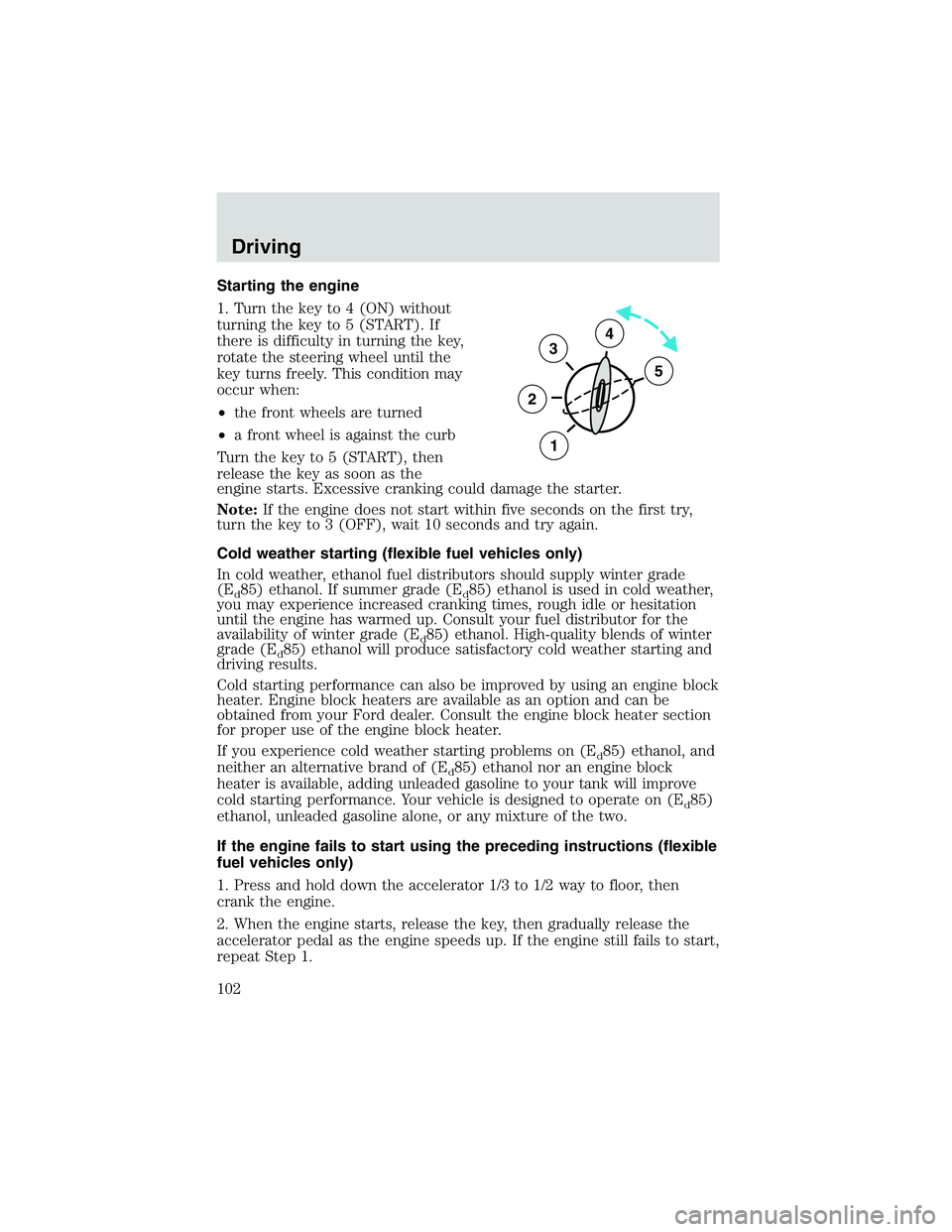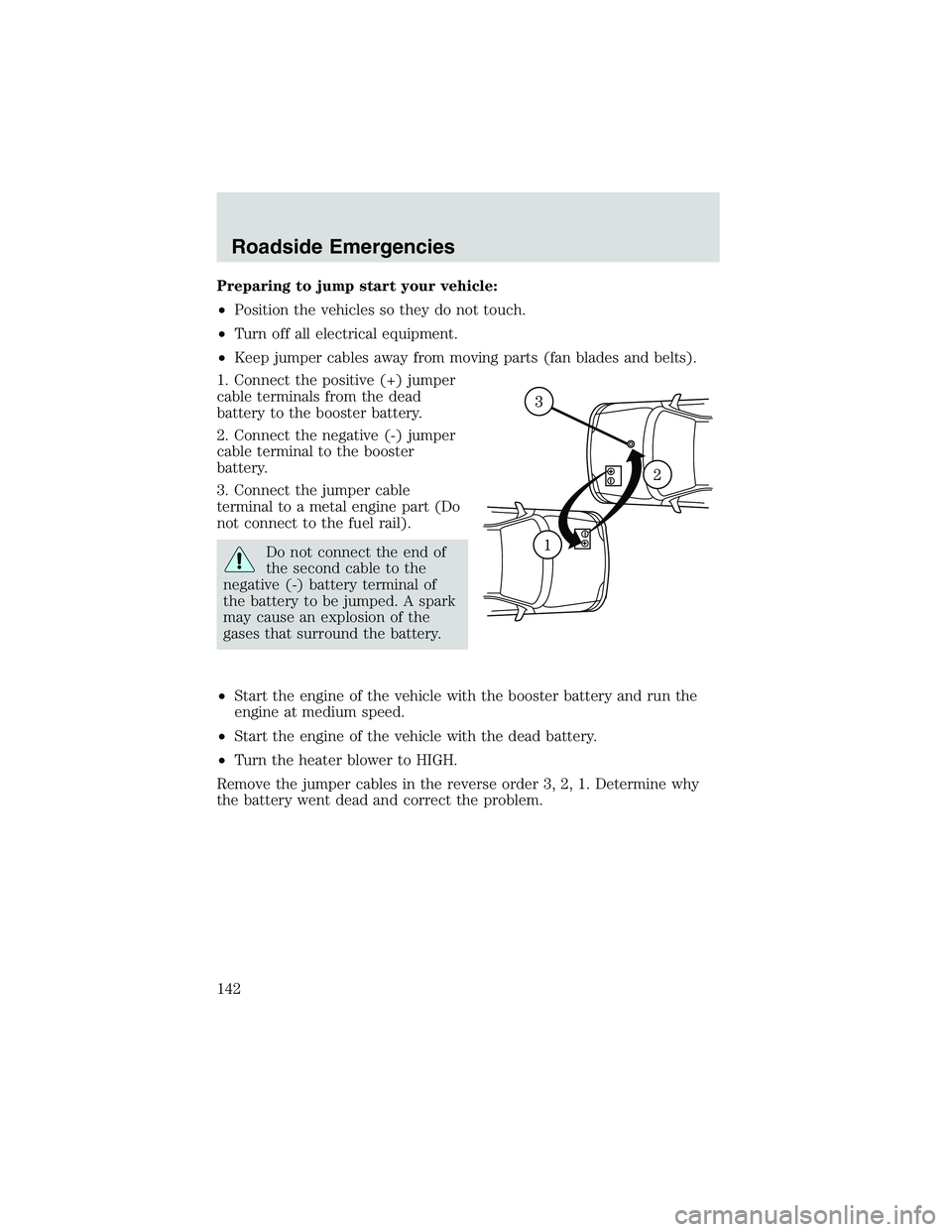2002 FORD EXPLORER SPORT TRAC heater
[x] Cancel search: heaterPage 102 of 200

Starting the engine
1. Turn the key to 4 (ON) without
turning the key to 5 (START). If
there is difficulty in turning the key,
rotate the steering wheel until the
key turns freely. This condition may
occur when:
•the front wheels are turned
•a front wheel is against the curb
Turn the key to 5 (START), then
release the key as soon as the
engine starts. Excessive cranking could damage the starter.
Note:If the engine does not start within five seconds on the first try,
turn the key to 3 (OFF), wait 10 seconds and try again.
Cold weather starting (flexible fuel vehicles only)
In cold weather, ethanol fuel distributors should supply winter grade
(E
d85) ethanol. If summer grade (Ed85) ethanol is used in cold weather,
you may experience increased cranking times, rough idle or hesitation
until the engine has warmed up. Consult your fuel distributor for the
availability of winter grade (E
d85) ethanol. High-quality blends of winter
grade (E
d85) ethanol will produce satisfactory cold weather starting and
driving results.
Cold starting performance can also be improved by using an engine block
heater. Engine block heaters are available as an option and can be
obtained from your Ford dealer. Consult the engine block heater section
for proper use of the engine block heater.
If you experience cold weather starting problems on (E
d85) ethanol, and
neither an alternative brand of (E
d85) ethanol nor an engine block
heater is available, adding unleaded gasoline to your tank will improve
cold starting performance. Your vehicle is designed to operate on (E
d85)
ethanol, unleaded gasoline alone, or any mixture of the two.
If the engine fails to start using the preceding instructions (flexible
fuel vehicles only)
1. Press and hold down the accelerator 1/3 to 1/2 way to floor, then
crank the engine.
2. When the engine starts, release the key, then gradually release the
accelerator pedal as the engine speeds up. If the engine still fails to start,
repeat Step 1.
3
2
1
5
4
Driving
102
Page 103 of 200

Using the engine block heater (if equipped)
An engine block heater warms the engine coolant which aids in starting
and heater/defroster performance. Use of an engine block heater is
strongly recommended if you live in a region where temperatures reach
-23°C (-10°F) or below. For best results, plug the heater in at least
three hours before starting the vehicle. The heater can be plugged in the
night before starting the vehicle.
To prevent electrical shock, do not use your heater with
ungrounded electrical systems or two-pronged (cheater)
adapters.
Guarding against exhaust fumes
Carbon monoxide is present in exhaust fumes. Take precautions to avoid
its dangerous effects.
If you smell exhaust fumes inside your vehicle, have your dealer
inspect your vehicle immediately. Do not drive if you smell
exhaust fumes.
Important ventilating information
If the engine is idling while the vehicle is stopped for a long period of
time, open the windows at least 2.5 cm (one inch) or adjust the heating
or air conditioning to bring in fresh air.
BRAKES
Occasional brake noise is normal. If a metal-to-metal, continuous grinding
or continuous squeal sound is present, the brake linings may be worn-out
and should be inspected by a qualified service technician. If the vehicle
has continuous vibration or shudder in the steering wheel while braking,
the vehicle should be inspected by a qualified service technician.
Four-wheel anti-lock brake system (ABS)
Your vehicle is equipped with an Anti-lock Braking System (ABS). This
system helps you maintain steering control during emergency stops by
keeping the brakes from locking. Noise from the ABS pump motor and
brake pedal pulsation may be observed during ABS braking; any
pulsations or mechanical noise you may feel or hear is normal.
ABS warning lamp
ABS
TheABSlamp in the instrument cluster momentarily illuminates when
the ignition is turned to ON. If the light does not illuminate during start
up, remains on or flashes, the ABS may be disabled and the ABS may
need to be serviced
Driving
103
Page 142 of 200

Preparing to jump start your vehicle:
•Position the vehicles so they do not touch.
•Turn off all electrical equipment.
•Keep jumper cables away from moving parts (fan blades and belts).
1. Connect the positive (+) jumper
cable terminals from the dead
battery to the booster battery.
2. Connect the negative (-) jumper
cable terminal to the booster
battery.
3. Connect the jumper cable
terminal to a metal engine part (Do
not connect to the fuel rail).
Do not connect the end of
the second cable to the
negative (-) battery terminal of
the battery to be jumped. A spark
may cause an explosion of the
gases that surround the battery.
•Start the engine of the vehicle with the booster battery and run the
engine at medium speed.
•Start the engine of the vehicle with the dead battery.
•Turn the heater blower to HIGH.
Remove the jumper cables in the reverse order 3, 2, 1. Determine why
the battery went dead and correct the problem.
Roadside Emergencies
142
Page 192 of 200

Comfort and convenience
Engine block heater
Electrochromic compass mirror
Electrochromic compass mirror with temperature display
Side window deflectors
Speed control
Tire step
Travel equipment
Bike carriers
Luggage/cargo carrier
Raised cross bars
Roof rack (removable)
Ski/snowboard carrier
Seatback organizer (with removable headrest)
Soft luggage cover
Trailer hitch assembly
Trailer hitch balls (all capacities)
Trailer hitch bar
Wiring harness
Protection and appearance equipment
Cargo liners—soft, interior
Cargo organizer
Carpeted cargo mat
Cargo tray—hard, interior
Cover—front end (full, sport)
Door edge guards
Exterior cover
Floor mats—(all weather, carpeted, catch all)
Hood deflectors
Luggage hold down net
Molded splash guards
Accessories
192
Page 195 of 200

Ford accessories for your
vehicle .....................................157
Ford Extended Service
Plan ..........................................146
Getting assistance outside the
U.S. and Canada .....................150
Getting roadside assistance ...125
Getting the service you
need .........................................144
Ordering additional owner’s
literature .................................151
The Dispute Settlement
Board .......................................147
Utilizing the
Mediation/Arbitration
Program ...................................150
D
Doors
lubricant specifications ..........186
Driving under special
conditions ..........................112, 114
sand .........................................113
snow and ice ...........................115
through water .........................116
E
Engine ........................................188
cleaning ...................................154
lubrication
specifications ..................186, 188
refill capacities ........................183
service points ..........................160
starting after a collision .........126
Engine block heater .................103
Engine oil
filter, specifications ................183
refill capacities ........................183
specifications ..................186, 188Exhaust fumes ..........................103
F
Floor mats ...................................54
Fluid capacities .........................183
Foglamps .....................................33
Four-Wheel Drive vehicles .......111
description ..............................111
driving off road .......................112
electronic shift ........................112
indicator light .........................111
preparing to drive your
vehicle .....................................105
Fuel
capacity ...................................183
filling your vehicle with fuel ..171
filter, specifications ................183
fuel pump shut-off switch .....126
octane rating ...........................188
G
Garage door opener ....................43
Gauges .........................................11
GAWR (Gross Axle Weight
Rating) .......................................116
calculating ...............................118
definition .................................116
driving with a heavy load ......116
location ....................................116
GVWR (Gross Vehicle Weight
Rating) .......................................116
calculating .......................116, 118
definition .................................116
driving with a heavy load ......116
location ....................................116
H
Head restraints ...........................73
Index
195